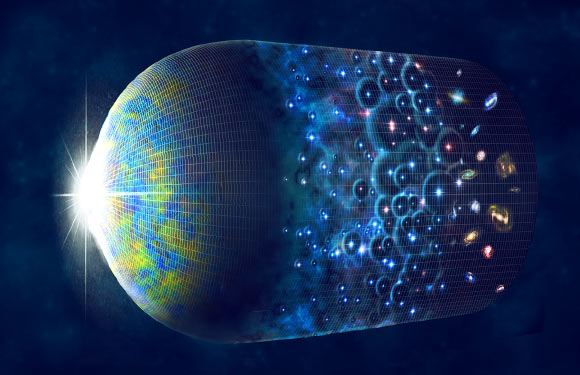Our Universe is Curved, Suggests New Study | Astronomy – Sci-News.com
The current model of the Universe needs to be revised, according to a new analysis of Cosmic Microwave Background (CMB) anisotropy data.

This artist’s impression shows the evolution of the Universe beginning with the Big Bang on the left followed by the appearance of the Cosmic Microwave Background. The formation of the first stars ends the cosmic dark ages, followed by the formation of galaxies. Image credit: M. Weiss / Harvard-Smithsonian Center for Astrophysics.
Precise measurements of CMB anisotropies — the direction in which radiation in space is moving — can determine with a high degree of accuracy the shape of the Universe.
The new data from ESA’s Planck satellite strongly suggests a Universe with positive curvature.
If true, this challenges the current, flat model of the Universe.
In a flat Universe, two parallel lines will travel forever without meeting. In a curved Universe, however, the two lines will eventually meet.
This has important ramifications in cosmology, as it suggests the existing inflationary theory, which describes the evolution of the Universe after the Big Bang, needs to be re-examined.
Previous experiments, such as NASA’s Wilkinson Microwave Anisotropy Probe (WMAP), have supported a flat theory.
The Planck Legacy 2018 release, however, with significantly better precision, has found the Universe is ‘nearly flat,’ but is still 4% more curved than was thought.
It also drives a wedge between the Planck data and other datasets, such as those from the BOSS DR14 survey.
Previously, the two datasets had been in agreement, but this was based on the assumption of a flat Universe.
Once curvature is considered, the two datasets are in disagreement.
“The current cosmological scenario, based on inflation, dark matter, and a cosmological constant, seems unable to fit all observations,” said lead author Dr. Eleonora Di Valentino, a researcher in the Jodrell Bank Centre for Astrophysics at the University of Manchester.
“Experimental systematics can still play a role, and it will be the duty of future experiments to scrutinize current discordances.”
“At the moment, however, the idea of a concordance cosmology is undoubtedly under pressure.”
The team’s paper was published November 4, 2019 in the journal Nature Astronomy.
_____
E. Di Valentino et al. Planck evidence for a closed Universe and a possible crisis for cosmology. Nat Astron, published online November 4, 2019; doi: 10.1038/s41550-019-0906-9






